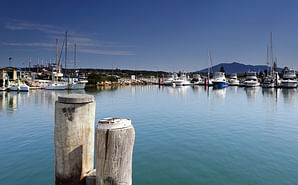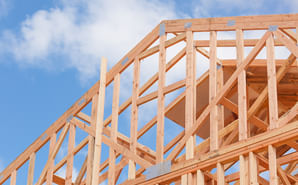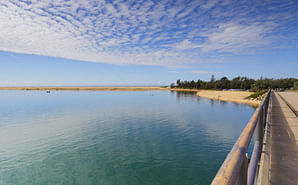Planning Considerations
Information about BAL ratings, BASIX, environment and cultural heritage assessments
The natural environment, economy and our social and cultural heritage all play a part in Bega Valley Shire Council’s planning processes. Below you will find information about:
- BASIX (building sustainability index) certificate
- BAL (Bushfire Attack Level) assessments
- Biodiversity Assessment
- KSEPP (State Environmental Planning Policy - Koala Habitat Protection)
- EPBC (Environmental Protection & Biodiversity Conservation)
- Asbestos
- Aboriginal Heritage
- Aboriginal Due Diligence
Basix Certificate
Basix, or building sustainability index, is a NSW Government planning measure to reduce household electricity and water use by setting minimum sustainability targets for new and renovated homes.
A Basix certificate is required for the construction of the following:
- new houses
- new townhouses and villas
- new dual occupancies
- new granny flats
- new flats and apartments
- renovations of$50,000 or more to an existing home
- swimming pools and/or spas larger than 40,000 litres
- the conversion of an existing non-residential building to a residential building.
How do I get a Basix certificate?
- You can generate a Basix certificate yourself or ask your architect or designer to do this for you. Use the online Basix assessment tool at www.planningportal.nsw.gov.au/basix
- All BASIX commitments need to be clearly shown on plans and specifications.
- The certificate is only valid for three months.
BAL Assessment
BAL (Bushfire Attack Level) measures the risk of a building’s potential exposure to ember attack, radiant heat and flame impact. There are 6 bushfire attack levels in total, these are low, 12.5, 19, 29, 40 and Flame Zone (FZ). The higher the risk, the more protection you need.
How do I get a free BAL assessment?
Properties that were bushfire impacted and need to rebuild, receive an assessment for free. Council can arrange for one of our staff to visit your property and determine your BAL rating for you. This will be only up to BAL 40 (not flame zone). To arrange an assessment email developmenthub@begavalley.nsw.gov.au
What can I do if I have a BAL rating of 40 or Flame Zone?
The additional costs to rebuild with a BAL 40 rating are significant, as you may need to include additional things in your budget, such as a metal water tank and non-combustible landscaping. It is best to contact a fire consultant to help plan your build.
If your property is determined to be FZ (Flame Zone) then you are required to include a full consultants report with your DA application.
To find a fire consultant go to http://www.fpaa.com.au/bpad.aspx

Biodiversity Assessment
Biodiversity legislation can be complex, and Council is committed to helping post fire rebuilds through the biodiversity assessment process as smoothly as possible. Contact Council as early as possible in the planning phase to discuss any biodiversity assessments/reports that may be required.
For rebuilds with minimal biodiversity impacts, e.g. rebuilding on the existing site with minimal requirement for native vegetation clearing, council will undertake any assessments on behalf of the applicant. Should more extensive clearing be required, e.g. rebuilding on a new site or extensive clearing for Asset Protection Zones or new access, council will advise the applicant on the biodiversity assessment requirements and who will be responsible for undertaking that assessment.
Implications of the following pieces of legislation will be considered in any post fire rebuild DA Assessment:
Biodiversity Conservation Act
The Biodiversity Offset Scheme threshold (BOS) Threshold is a test used to determine when is necessary to engage an accredited assessor to apply the Biodiversity Assessment Method (the BAM) to assess the impacts of a proposal.
The thresholds for entry into the BOS are any of the following:
- Development is located on the Biodiversity Values Map
- Area clearing threshold is exceeded (refer to Table 1 below)
- Impacts to threatened species/communities (determined through a test of significance)
If clearing and other impacts exceeds the trigger thresholds, the BOS applies to the proposed development and a Biodiversity Development Assessment Report (BDAR) must be prepared and submitted with their application.
| Minimum lot size associated with the property | Threshold for clearing, above which the BAM and offsets scheme apply |
|---|---|
| Less than 1 ha | 0.25 ha or more |
| 1 ha to less than 40 ha | 0.5 ha or more |
| 40 ha to less than 1000 ha | 1 ha or more |
| 1000 ha or more | 2 ha or more |
Table 1 Biodiversity Offsets Scheme clearing area thresholds (Council can confirm which minimum Lot size applies)
Applicants are advised to check their proposal against the first two thresholds above by accessing the Biodiversity Values Map and Threshold (BMAT) tool at: www.lmbc.nsw.gov.au/Maps/index.html?viewer=BOSETMap
A BMAT user guide can be found at: www.environment.nsw.gov.au/research-and-publications/publications-search/biodiversity-values-map-threshold-tool-user-guide
Council staff will assess the third threshold, impacts to threatened species, through a site visit. Should impacts to threatened species be likely further assessment by the applicant may be required.
Further information on the BOS can be found at the link below: www.environment.nsw.gov.au/topics/animals-and-plants/biodiversity/biodiversity-offsets-scheme/how-it-works
State Environmental Planning Policy - Koala Habitat Protection (KSEPP)
The KSEPP came into effect in March 2020, replacing the State Environmental Planning Policy No 44 – Koala Habitat Protection, and aims to protect Koala populations and their habitat.
Criteria for development applications under the KSEPP can be found in the new Guideline document (https://pp.planningportal.nsw.gov.au/draftplans/under-consideration/koala-habitat-protection-guideline) however Council staff will assist applicants by undertaking site inspections to determine the implications of the SEPP for each application. Further KSEPP information for landholders can be found at the link below: www.planning.nsw.gov.au/-/media/Files/DPE/Factsheets-and-faqs/faq-koala-SEPP-landholders-2020-03-20.pdf
An exemption to the Koala SEPP is now in place where the replacement dwelling is proposed on the same building footprint as the destroyed dwelling.
Commonwealth Environmental Protection and Biodiversity Conservation Act (EPBC Act)
The EPBC Act is the Australian Governments key piece of environmental legislation, focussing on the protection of matters of national environmental significance including species and ecosystems.
Potential impacts to matters of environmental significance need to be assessed as part of a Development Application and council staff will assist applicants through this process.
Further information on the EPBC Act and associated environmental assessment can be found at https://www.environment.gov.au/epbc/environment-assessment-and-approvals
My property has been identified as containing asbestos
Is there any additional paperwork I need before I can start my re-build?
Once the site has been cleaned by either the NSW Government’s appointed contractor or your self-appointed contractor, you will need to ask for the Occupational Hygienist’s Clearance Certificate. Council (or your Private Certifier) will need to sight a copy of that Certificate prior to the issue of a Construction Certificate.
What is an Aboriginal Heritage Information Management System Report and how do I get one?
The Aboriginal Heritage Information Management System (AHIMS) is a database that contains detailed information on recorded sites of Aboriginal and Cultural Heritage. It is used to help identify, manage, conserve and protect local sites and heritage. In line with the current legislation, we require an Aboriginal Heritage Information Management Systems (AHIMS) report (this is a 2-page document) as part of your Development Application.
Reports can be obtained from: www.environment.nsw.gov.au/awssapp/Login.aspx?ReturnUrl=%2fawssapp%2fMySearches.aspx
If you are having issues obtaining this report on your property, contact ahims@environment.nsw.gov.au
What is an Aboriginal Due Diligence Statement?
In accordance to legislative requirements, the Aboriginal Due Diligence Statement demonstrates that you have considered:
- any potential impacts on items of Aboriginal Heritage; plus
- the potential likelihood of Aboriginal artefacts being contained within the site to be disturbed; and
- that should any objects or places be found within the site; works will stop immediately and the relevant authorities will be contacted.
-
Report can be obtained from: www.environment.nsw.gov.au/-/media/OEH/Corporate-Site/Documents/Aboriginal-cultural-heritage/due-diligence-code-of-practice-aboriginal-objects-protection-100798.pdf






